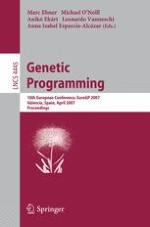2007 | Buch
Genetic Programming
10th European Conference, EuroGP 2007, Valencia, Spain, April 11-13, 2007. Proceedings
herausgegeben von: Marc Ebner, Michael O’Neill, Anikó Ekárt, Leonardo Vanneschi, Anna Isabel Esparcia-Alcázar
Verlag: Springer Berlin Heidelberg
Buchreihe : Lecture Notes in Computer Science
